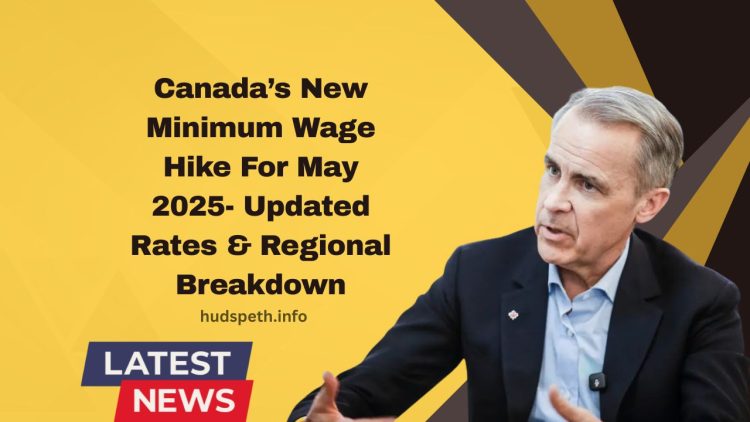Canada’s minimum wage landscape has undergone significant changes as of May 2025, with several provinces and territories implementing new wage rates.
These adjustments are primarily aimed at aligning with rising inflation, improving the standard of living, and ensuring economic equity across the nation.
Whether in the retail, hospitality, or gig economy sectors, this updated wage framework carries critical implications for both employers and employees.
Key Minimum Wage Increases by Region
The chart below outlines the updated minimum wage rates effective in 2025 across Canada’s jurisdictions:
| Jurisdiction | New Rate (2025) | Previous Rate | Effective Date | Notes |
|---|---|---|---|---|
| Federal | $17.75 | $17.30 | April 1, 2025 | CPI-based adjustment for federally regulated sectors |
| Quebec | $16.10 | $15.75 | May 1, 2025 | Tipped wage set at $12.90 |
| British Columbia | $17.85 | $17.40 | June 1, 2025 | Includes gig workers |
| Yukon | $17.94 | $17.59 | April 1, 2025 | Based on Whitehorse CPI |
| Nova Scotia | $15.70 | $15.20 | April 1, 2025 | Will rise to $16.50 by October 2025 |
| Ontario | $17.20 | $16.55 | October 1, 2024 | Scheduled to reach $17.60 by October 2025 |
| Manitoba | $15.80 | $15.30 | October 1, 2024 | Will increase to $16.00 by October 2025 |
| Newfoundland and Labrador | $16.00 | $15.60 | April 1, 2025 | CPI-tied increases |
| New Brunswick | $15.65 | $15.30 | April 1, 2025 | Adjusted annually via CPI |
| Nunavut | $19.00 | $16.00 | January 1, 2024 | Highest rate in Canada |
| Saskatchewan | $15.00 | $14.00 | October 1, 2024 | CPI-based increase |
| Prince Edward Island | $16.00 | $15.70 | October 1, 2024 | To reach $16.50 in 2025 |
| Alberta | $15.00 | $13.60 (students) | October 1, 2018 | No recent updates |
| Northwest Territories | $16.70 | $16.05 | September 1, 2024 | Adjusted with Yellowknife CPI |
Understanding the Wage Adjustments
Federal Rate Update
The federal minimum wage rose to $17.75 per hour starting April 2025. This applies to sectors under federal regulation, including airlines, banks, and telecommunications. If the provincial wage is higher, that rate overrides the federal amount.
Provincial Trends
Many provinces now tie wage updates to Consumer Price Index (CPI) figures, helping maintain purchasing power. For example, British Columbia will increase its minimum wage to $17.85 by June 2025, while Nova Scotia and Ontario are planning future hikes within the year.
Top Performer: Nunavut
Nunavut leads the country with a $19.00 per hour minimum wage, a necessary adjustment due to its extremely high cost of living.
Sector-Wide Impact of the Wage Hike
- Hospitality & Food Services: Heavily reliant on minimum wage workers, these industries may raise menu prices or reduce hours to manage costs.
- Retail: A shift toward part-time roles is expected as businesses look to minimize labor expenses.
- Gig Economy: Provinces like British Columbia are expanding wage protections for ride-share and delivery workers.
Economic Context and Historical Background
The history of minimum wage in Canada dates back to 1918 in British Columbia, evolving from basic labor protections to tools for reducing income inequality. Today, minimum wages are seen as mechanisms for economic justice and poverty reduction.
Canada’s current average minimum wage places it ahead of the United States but slightly behind countries like Australia, which offers over CAD $21 per hour.
Case Examples
- Retail Worker in Ontario:
Working 35 hours per week at $17.20/hr earns approximately $31,276 annually, before tax. - Student in Nova Scotia:
Working 20 hours a week at $15.70/hr could earn around $16,336 yearly, supporting education or living expenses.
Practical Guidance
For Employees:
- Check Pay Stubs: Ensure wages reflect updated rates.
- Upskill and Train: Use additional income to enhance qualifications.
- Negotiate Benefits: With wages up, negotiating for bonuses or better shifts becomes more viable.
For Employers:
- Update Systems: Payroll must comply with legal changes.
- Communicate Changes: Be transparent with staff.
- Adjust Budgets: Reassess pricing and staffing strategies.
Future Outlook
Many jurisdictions are now opting for automatic wage adjustments tied to inflation, reducing political delays and ensuring predictability for businesses and employees alike. By the end of the decade, a more consistent national standard may emerge.
The May 2025 minimum wage adjustments across Canada underscore the country’s dedication to economic fairness, inflation alignment, and improved worker protections. Staying informed and prepared will allow both employees and businesses to adapt smoothly to this evolving labor environment.
FAQs
What is the highest minimum wage in Canada as of May 2025?
Nunavut has the highest rate at $19.00 per hour, reflecting its high cost of living.
When does Ontario’s minimum wage increase again?
Ontario’s minimum wage is set to rise to $17.60 in October 2025.
Are tipped workers subject to the same minimum wage?
No, tipped workers, such as in Quebec, have a lower base wage, currently at $12.90 per hour.

